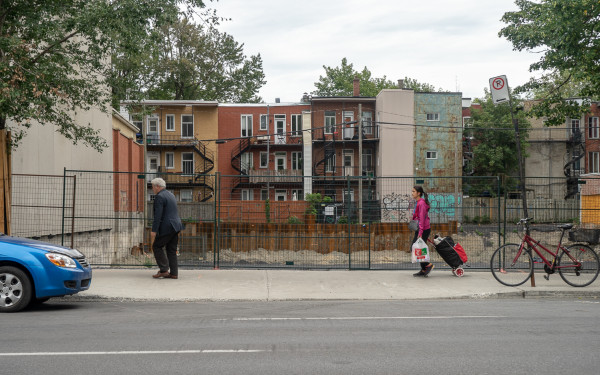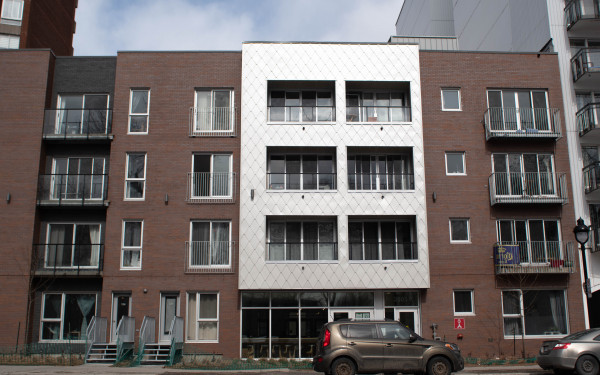Give me a Home Where the Undergrads Roam
CSU Advances Student Housing Initiative
With a little time and investment, Concordia students will eventually be removed from Montreal’s tenant market. At least that’s the goal of the Concordia Student Union’s ongoing housing campaign.
The project to develop cooperative housing for students is moving forward with the help of a student-led housing research group and social investors at the Chantier de l’économie sociale.
A question during last November’s CSU by-election concerning the prioritization of the project passed easily—but now students need to approve the money to back it up.
The student union will ask undergrads to vote in next month’s general election to transfer $1.85 million from the Student Space, Accessible Education and Legal Contingency fund to a new fund dedicated to developing a housing complex.
The student space fund contains about $12 million collected from an annual fee levy and can be used for initiatives that fulfill a broad mandate—essentially long-term projects that improve the student experience.
Last semester, students approved a $102,536.79 transfer of funds to pay back start-up costs for the Hive Café co-ops, which opened in September on both campuses.
At the last CSU meeting, Nancy Neamtan, the CEO at the Chantier de l’économie sociale, agreed to invest up to $1.5 million into the housing project. Desjardins has shown interest in financing the rest of the costs with a mortgage.
The Chantier de l’économie sociale specializes in “patient capital” or investments with long-term goals and low interest rates.
The idea is to charge residents 80 per cent of the rental market’s median, based on the neighbourhood. Montreal’s Sud-Ouest borough is a viable option, says VP Academic and Advocacy Terry Wilkings, for its low housing costs and proximity to Concordia.
Student co-ops are supposed to be the alternative to university-run residences and a speculative housing market.
“I don’t believe that the university has the capacity to provide housing for the entire student population,” he said. “This isn’t a problem that’s isolated to Concordia.”
There are only about 900 rooms at Concordia residences and they only house first-year students. Combined, student residences house about 5,000 students in Montreal, which is home to over 190,000 students, according to a market study.
A feasibility study produced for the CSU also shows that students are targets in the renting market, usually when it comes to illegal deposits, documents and inhabitable conditions.
Students from outside the city also pay on average $100 more on rent per month.
The study was produced by the Unité de travail pour l’implantation de logement étudiant (UTILE)—a not-for-profit group working with student unions in Montreal and at the Université Laval on student tenant surveys.
UTILE is already working on its own housing co-op in the Sud-Ouest with $2 million from the provincial government. A website for information on renting in Montreal was also launched with the CSU’s Housing and Job Bank. Wilkings says he’s also working on an information campaign.
Development and funding scenarios were presented to the CSU’s council last semester, providing models for repurposing residential or commercial buildings, as well as a one-time equity investment or loan to finance the project.
Those methods are one-off projects that won’t really change the housing market for students, says Wilkings.
“Something that is a priority for the CSU is to make affordable housing as accessible as possible,” he said. This means having access to long-term finances.
Instead the CSU opted to set up an investment fund—the Popular University Student Housing fund—which will act like a loan that pays itself back to finance more projects.
Unlike a fee-levy, the PUSH fund will be created through a one-time transfer that will sustain itself.
“There is not going to be a need to continuously receive support from students in the form of student money for this fund,” Wilkings said.
The fund would be loaning money to develop a co-op, with a social mandate so that repayment is below standard market rates.
This means rent will be kept as low as possible, because the interest rate is kept as low as possible, but not so low that the fund loses value. Bank loans, on the other hand, tend to charge higher rates to make a profit.
“The whole model is structured around having access to cheap money,” said Wilkings.
The CSU decided to follow UTILE’s lead in designing a new building instead of repurposing one that might need substantial renovation. The building is supposed to be adapted to student needs and have 100 to 150 rooms for Concordia students.
Ideally everything would be in place by fall 2016. But realistically, Wilkings says students will probably be able to rent a room in 2017. If the initial project works out, the potential for more construction will be maintained through the PUSH fund’s returns.
“Nothing prevents the CSU from continually benefitting from the fund and it allows us to seek further support from other organizations,” he said. In addition to the Chantier, the CSU is soliciting help from other unnamed social investors.
The concept for student co-op housing in Montreal and other parts of the province are inspired by similar projects in the Netherlands and Sherbrooke, Quebec.
University students across North America, like at Guelph and Minnesota, also run housing co-ops.
Nancy Neamtan is excited about bringing the idea to Montreal. Neamtan works on the board of UTILE.
“This would be the first time that we would have been approached and working with a student organization,” she said. “But we think it’s a tremendous opportunity and a really interesting initiative.”
The Chantier, she says, uses “traditional economic tools for social good” to invest its $52-million “patient capital” fund. These types of investment are considered good solid investments—not speculative—bringing stable returns.
“There’s always the question, for many years what went on in the investment community was getting rid of the bad stuff, chemical weapons, child labour,” she said. “The challenge now is not taking in the bad stuff but investing in the good stuff.”
These projects are so successful, according to Neamtan, because they respond to specific needs. The survival rate of co-ops is three times the rate of traditional private businesses.
Organizations leading the projects are also scrutinized if they fail. The CSU can’t sell out, cross the street and open up under a new name, for example.
“If the model has to be adjusted a little bit, then we’ll figure out ways to adjust it,” she said. “We’re not a bank that says yes or no.”

_223_213_90.jpg)
_600_832_s.png)




